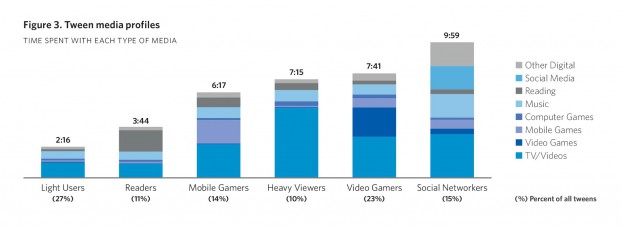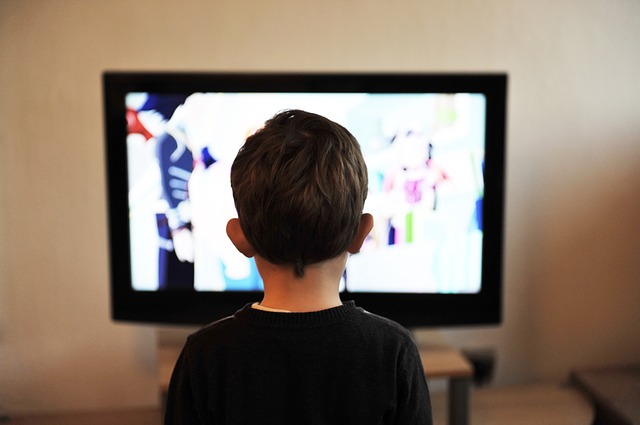All in all, I give myself a B. A few right, a few wrong, a few “incomplete.”
Two weeks ago, I predicted the findings of the Common Sense Media Media Use by Tweens and Teens census, conducted by Vicky Rideout and unveiled at a Washington forum (video courtesy of Scott Traylor).
Some of my forecasts were obvious. That time spent with media would remain astronomical was a mortal lock. The array of devices and the variety of content outlets has only expanded since the last study was done, five years ago. The tablet – now one of tweens’ top tools – wasn’t even on the market. (NB: due to methodology changes, this report can’t be compared directly to that 2010 study.)

The other half of that prediction – that multi-tasking would become sequential-tasking as kids adopted “one screen to rule them all” devices – is harder to assess. Young people still double and triple up on media use, cramming tweens’ six hours of daily use and teens’ almost nine into fewer linear hours. Einstein wouldn’t be able to fathom how they compress time. There’s still a lot of simultaneous action, but the laundry list of their tablet and smartphone uses suggests they must engage sequentially on single devices, too.
Happily, in detailing the media profusion, the Common Sense report acknowledges that “screen time” is no longer a valid construct. “If ‘screen media use’ can mean writing a short story on a computer, video-chatting with relatives, watching videos, reading the news online, or playing games,” the study asks, “what is the point of documenting the total amount of time teens spend using screens?”
Instead, and more usefully, the researchers segmented tweens and teens into user types. This section of the Common Sense Census may be the most important and constructive for multiplatform content creators. The usage combinations and time balances detailed to define groups like Light Users and Heavy Users, Social Networkers, Game/Computer Users and more are incredibly valuable (see chart above). They can help you form a picture of your desired or likely audiences, so as not to waste time or resources chasing ghosts.
Two weeks ago, I suggested that reports of TV’s death are greatly exaggerated. Indeed, television came through as tweens’ most-used and most-liked activity, and teens’ second behind music listening. Added together, time with TV, videos and DVDs (old skool!) tops “average time per day” for both ages.
What’s clear in the report, however, is the difficulty of defining and measuring “television.” The Census uses four somewhat hazy categories: TV as Broadcast, TV Time-Shifted, TV Online and Online Videos. Netflix is listed as time-shifting, odd for an unscheduled, “pull” platform. Wouldn’t it fit better into TV Online, defined as “TV shows or movies downloaded or streamed to a computer, tablet, or smartphone”? Online Videos specifically excludes TV shows or movies, but isn’t it a tautology if a TV show is defined by having appeared on a TV channel? How is Stampy’s “WonderQuest” show on YouTube not TV, and what of the many YouTube channels comprised of series, like the Fine Brothers’ REACT.
So, let me make an early prediction that we’ll learn a lot about kids’ motivations and gratifications in video viewing, guiding survey redesign…in 2020.
There’s not really an answer to my line that no one uses Facebook any more; it’s too crowded. The Census wasn’t granular enough to compare specific social platforms. It did find, however, that teens are less enamored of social media than we’ve believed. Yes, they use multiple apps for sharing and communicating, but it feels more obligatory than fulfilling. Only 36 percent enjoy using social “a lot;” only 10% say it’s their favorite thing to do with media. On any given day, 42% don’t use it at all.
As to whether the digital divide is subsiding into a mobile meld, I’ll mark myself wrong. Children in lower-income families are still much less likely to have a broad array of digital kit at home. 54 percent of lower-income teens (<$35,000 a year) have a laptop at home, compared with 92 percent of higher-income teens (>$100,000). Equity isn’t just about hardware; 10% of lower-income teens still have dial-up Internet (one might assume many also have limited mobile data plans).
There is a glimmer of hope, though. While lower-income teens are less likely to own their own smartphones (51% vs. 78 %), the divide in personal ownership of tablets among tweens is smaller (48% vs. 56%). Tweens use tablets more than smartphones; for teens, it’s vice versa.
I imagine there’s a wealth of interesting stories about families’ priorities and choices about technology, in the less-well-detailed middle-income group.
The Common Sense report has many other important insights, and it raises a slew of questions. Here are just a few:
Console gaming shows a huge gender disparity. Twenty seven percent of male teens list video games as their favorite media activity, compared to 2% of females (for tweens, it’s 38%/6%). Computer and mobile games are more balanced among tweens but not teens (who barely register mobile game use overall).
Given this, where do we get the growing number of adult gamer women? We know they’re out there; when and why do females become gamers?
In initial report coverage, many commenters were shocked that only 3% of tweens’ and teens’ time went to creating with media, rather than consuming. Many misquoted this as being only 3% of kids making content, but among teens nearly a fifth create digital art or graphics, 12% compose music, 11% build or “mod” games and 10% code.
The “content creation” figure came from a wider chart breaking out “passive consumption,” “active consumption,” “communication” and “creation.” Many people had questions or qualms about how various pursuits were categorized; principal investigator Vicky Rideout acknowledges that people might categorize behaviors differently. Common Sense welcomes this discussion and is open to others using its data to propose their own parsings.
The study’s biggest limitation is that it’s almost entirely “quant,” not “qual.” It tells little about favorite content, genres or brands; it doesn’t include use shifting patterns across the day; or say when media is consumed alone, with friends or with family. To do so all in one study would be cumbersome and expensive.
Today, however, content and context are critical. By the age of eight, kids’ interests begin to splinter and they use media to pursue passions and form communities, more than consuming what’s pushed toward them.
There are companies and organizations that dig deeper into specific uses, preferences, motivations and such. My company, Dubit, for example, runs a quarterly Trends survey that would dovetail nicely with the Common Sense Census.
“Stone Soup” is a classic children’s story where everyone in the village contributes a small something toward a rich soup that feeds all. Maybe it’s a good time for a kids and media research “stone soup,” where we make turn a collection of snapshots into a 360, 3D portraits of kids’ lives with media.
Graphic Credit: The Common Sense Census: Media Use by Tweens and Teens, Common Sense (2015)






















